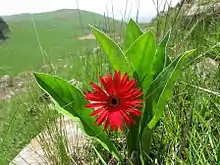Gerbera aurantiaca
Gerbera aurantiaca, the Hilton daisy, is a long-lived KwaZulu-Natal mistbelt grassland endemic and is a charismatic species because of its spectacular red flowers.[1]
| Gerbera aurantiaca | |
|---|---|
 | |
| Scientific classification | |
| Kingdom: | Plantae |
| Clade: | Tracheophytes |
| Clade: | Angiosperms |
| Clade: | Eudicots |
| Clade: | Asterids |
| Order: | Asterales |
| Family: | Asteraceae |
| Genus: | Gerbera |
| Species: | G. aurantiaca |
| Binomial name | |
| Gerbera aurantiaca Sch.Bip. | |
Description
The Hilton daisy is a relative of the common Barberton daisy. While the typical colour of the Hilton daisies is red, the flowers range from yellow through orange to bright red and deep scarlet. The Hilton daisy is an endangered species and only 15 viable populations of the species are known to exist.[2]
History
The Hilton daisy was first discovered by Christian Ferdinand Krauss during his visit to Natal in 1839.[3] They were first described by botanist Schulz Bipontinus in 1844 and named for the brilliant orange colour of the specimen sent over to Europe.[3] The Hilton daisy is named after Hilton College and the nearby village of Hilton,[4] and has an emotive association with both the college and the village.
References
- Brian, Tarr. "SABONET Threatened Plants - Hilton Daisy". Southern African Botanical Diversity Network. Archived from the original on 2 February 2014. Retrieved 20 January 2014.
- "The Hilton Daisy". Hilton College. Retrieved 20 January 2014.
- Johnson, Isabell. "Hilton daisy clings to life". The Natal Witness. Retrieved 20 May 2013.
- Johnson, Isabel. "Gerbera aurantiaca". PlantZAfrica.com. Retrieved 20 May 2013.
